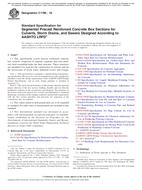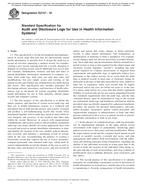1.1 This test method covers the determination of the pore volume and the pore volume distributions of soil and rock by the mercury intrusion porosimetry method. The range of apparent diameters of pores for which this test method is applicable is fixed by the operating pressure range of the testing instrument. This range is typically between apparent pore entrance diameters of about 100 μm and 2.5 nm (0.0025 μm). Larger pores must be measured by another method.
1.2 Mercury intrusion porosimetry is useful only for measuring pores open to the outside of a soil or rock fragment; mercury intrusion porosimetry will not give the volume of any pores completely enclosed by surrounding solids. This test method will give only the volume of intrudable pores that have an apparent diameter corresponding to a pressure within the pressurizing range of the testing instrument.
1.3 Mercury intrusion may involve the application of high pressures to the specimen. This may result in a temporary or permanent alteration or both in the pore geometry. Generally, soils and rocks are composed of comparatively strong solids and are less subject to these alterations than certain other materials. However, the possibility remains that the use of this test method may alter the natural pore volume distribution that is being measured.
1.4 All observed and calculated values shall conform to the guidelines for significant digits and rounding established in Practice D6026.
1.5 Warning-Mercury has been designated by EPA and many state agencies as a hazardous material that can cause central nervous system, kidney and liver damage. Mercury, or its vapor, may be hazardous to health and corrosive to materials. Caution should be taken when handling mercury and mercury-containing products. See the applicable product Material Safety Data Sheet (MSDS) for details and EPA's website (http://www.epa.gov/mercury/faq.htm) for additional information. Users should be aware that selling mercury or mercury-containing products or both into your state may be prohibited by state law.
1.6 The values stated in SI units are to be regarded as standard. No other units of measurement are included in this standard.
1.7 This standard does not purport to address all of the safety concerns, if any, associated with its use. It is the responsibility of the user of this standard to consult and establish appropriate safety and health practices and determine the applicability of regulatory limitations prior to use. For specific precaution statements, see Section 8.
Product Details
- Published:
- 05/01/2010
- Number of Pages:
- 7
- File Size:
- 1 file , 120 KB
- Redline File Size:
- 2 files , 270 KB


